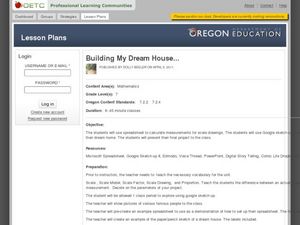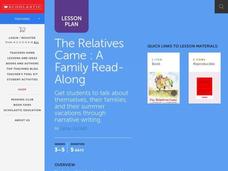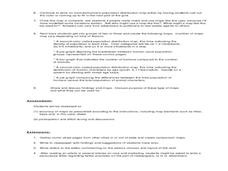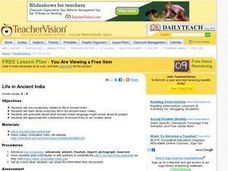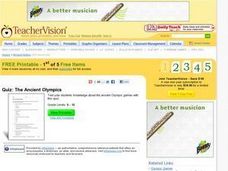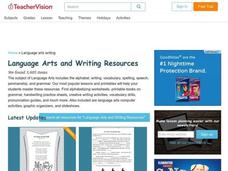Curated OER
Reading-Author's Purpose
Students review what author's purpose is by understanding that authors either persuade, inform, describe, or entertain with their story. In this language arts lesson plan, students bring in junk mail and in small groups discuss what the...
Curated OER
Academic Challenge
Students apply their knowledge of math to the real world. In this algebra instructional activity, students explore different way to incorporate math topics into the real world. They create a score or progress sheet to mark their progress.
Curated OER
Newspaper Lesson Plan
Students create a newspaper in order to examine the process and impact of political revolutions. In this newspaper lesson, student analyze the impact of selected revolutions while discussing the language style of each newspaper. Students...
Curated OER
Building My Dream House
Students create their dream house using a spreadsheet for measurements. In this measurements and drawings lesson, students apply concepts of units and conversions as they build and create different shapes. They use Google Sketch-up...
National Endowment for the Humanities
Nathaniel Hawthorne and Literary Humor
Young scholars examine Nathaniel Hawthorne's style of humor and compare it to other humorists. They discuss the purpose of literary humor and determine how it develops characters and plots in stories. They analyze the use of different...
Curated OER
Project Ahupua`a: Map Construction
Fourth graders construct a relief map of the Big Island of Hawaii. They work in groups to conduct research, design and construct the map. Students use clay, gessoed boards and reference maps in their projects.
Curated OER
Humor and Iconicity in Classical Music
Scherzo, cappricio, divertimento, and rando are all addressed in this look into humor through this classical music presentation. The slide show is very basic, but has some good background on Mozart, Haydn, Beethoven, and Bach. The...
Curated OER
American Revolution Vocabulary Cartoons (art)
Fifth graders discuss cartoons. In this art lesson, 5th graders make their own cartoon using vocabulary words from the American Revolution.
Curated OER
Superheroes
Middle schoolers, in groups, brainstorm what they know about superheroes. They examine their powers and how they became a superhero. They read handouts and answer questions to test for comprehension.
Curated OER
Narrative Cartoons
Students compare and contrast the traditional superhero cartoon with a narrative cartoon. Students research water resources and usage in Africa and create original narrative cartoons showcasing their findings.
Curated OER
The Relatives Came: A Family Read-Along
Students read the book, 'The Relatives Came' by Cynthia Rylant to revive memories about their own summer vacations and family customs. They write a friendly letter about a fantasy summer vacation--"What I Wish I Did on My Summer...
Curated OER
What is the Population Distribution of Cartoon Characters Living On the Pages of Your Newspaper?
Students read various cartoons in their local newspaper and calculate the population demographics, spatial distribution and grouping of the characters. Using this information, they create a population distribution map and share them with...
Curated OER
Snake and Sight Word Board Game
Students practice sight words. Game begins with the first student rolling a die and moving the number of spaces shown on the die. If they lands on a shaded square, he or she turns up a card and reads it aloud.
Curated OER
Life in Ancient India
Students study Ancient India and the vocabulary, language, and everyday life associated with India. They build a time capsule representing their own world for future civilizations to discover. They create labels for each item, giving a...
Curated OER
A Day at the Ancient Olympics
Learners examine how athletes from various ancient Greek city-states behaved at the Olympic Games. They conduct Internet research, take notes on a worksheet, and write a screenplay for a television drama about the Olympic Games in...
Curated OER
Fact and Opinion Detectives
Third graders see how to distinguish facts from opinions in a child's news magazine. After a lecture/demo, 3rd graders utilize a sample story and a worksheet which gives them practice in distinguishing fact from opinion.
Curated OER
The Global Warming Cover-Up
Learners explore the basic background on the causes of global climate disruption and governmental and economic reasons for downplaying its causes. Key reasons why US citizens have largely ignored the issues are examined in this lesson.
Curated OER
Genetically Modified Foods
Students investigate the risks of genetically modified organisms. They examine web site that contain information about GMO's and share the information with other adults.
Curated OER
"Green Holiday Night" or "Green Family Night"
Students examine alternatives to wasteful, non-environmental holiday season and general gift-giving practices and discuss ideas for saving energy in holiday celebrations and day-to-day practices.
Curated OER
Art and Influence of Theatre
Pupils examine an 18th century drawing and produce a skit based on the drawing. In this art analysis instructional activity, students analyze the story depicted in a drawing and create a skit inspired the scene. Pupils research the 18th...
Curated OER
I Know Why the Caged Bird Sings
Students read and analyze the novel "I Know Why the Caged Bird Sings" by Maya Angelou. They discuss the poetry and prose of the book, the importance of role models, complete a worksheet, and write a narrative using figurative language.
Curated OER
In From Out of Town
Learners explore how the introduction of foreign species negatively affects native Hawaiian bird species. In this science lesson, students discuss how various species were introduced to Hawaii and the effects of these species on native...
Curated OER
Lesson 13- Lucille Ball: What's So Funny
Students study who were important in Hollywood cinema in the 1940's, 1950's and today. They participate in a comedy improv exercise.
Curated OER
Integrating Anime and Manga into an Art of Motion Picture Course
Students examine the art of Anime and note its characteristics. Using scenes, they identify the plots, characters and themes trying to be portrayed. In groups, they compare and contrast the animation in America to that of Anime and...
Other popular searches
- Comic Strips Powerpoint
- Onomatopoeia Using Comics
- Comic Protagonist
- Making Comic Strips
- Comic Strip Sequence
- Comic Strip Writing
- Comic Relief
- American Comics
- Comic Stips
- Editorial Cartoons & Comics
- Comic Strip Template
- Writing Comics



